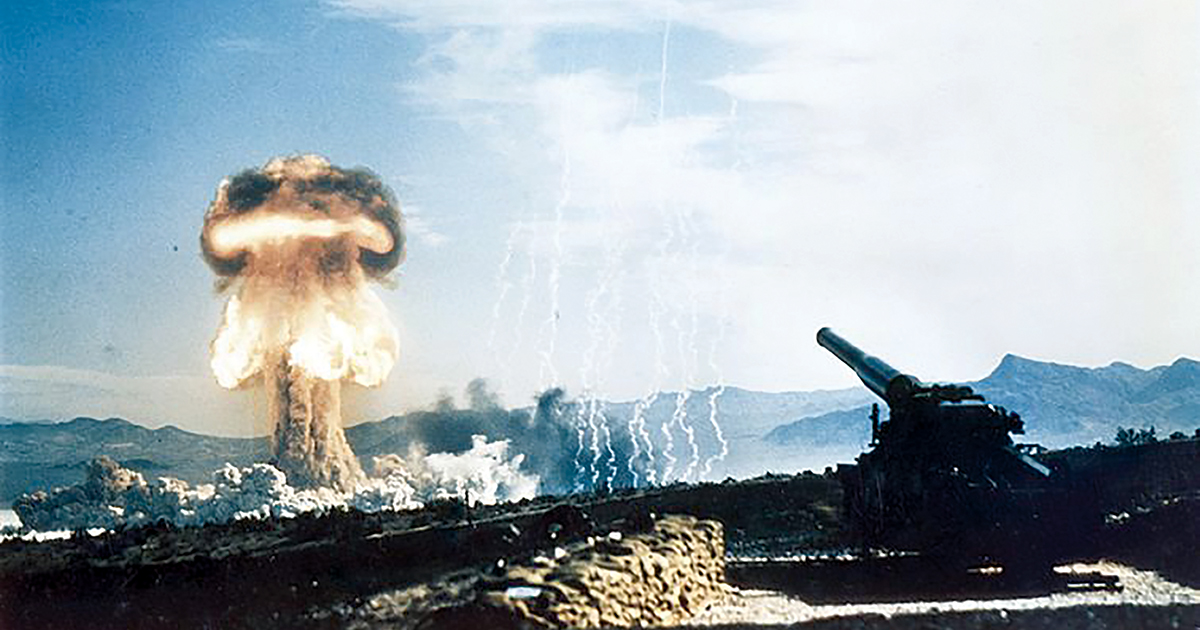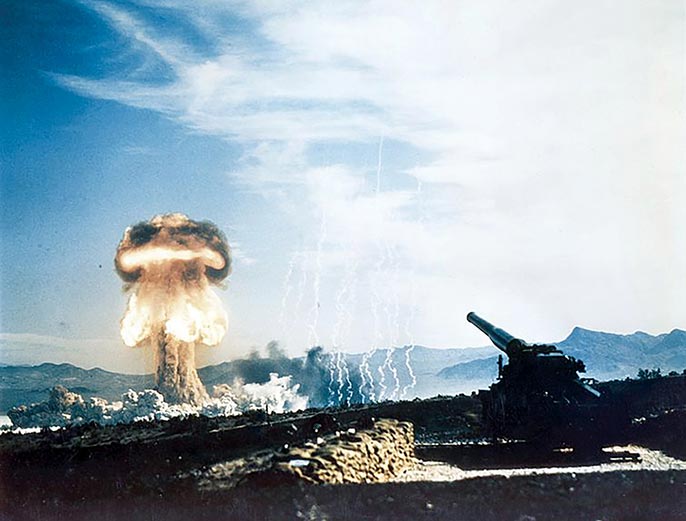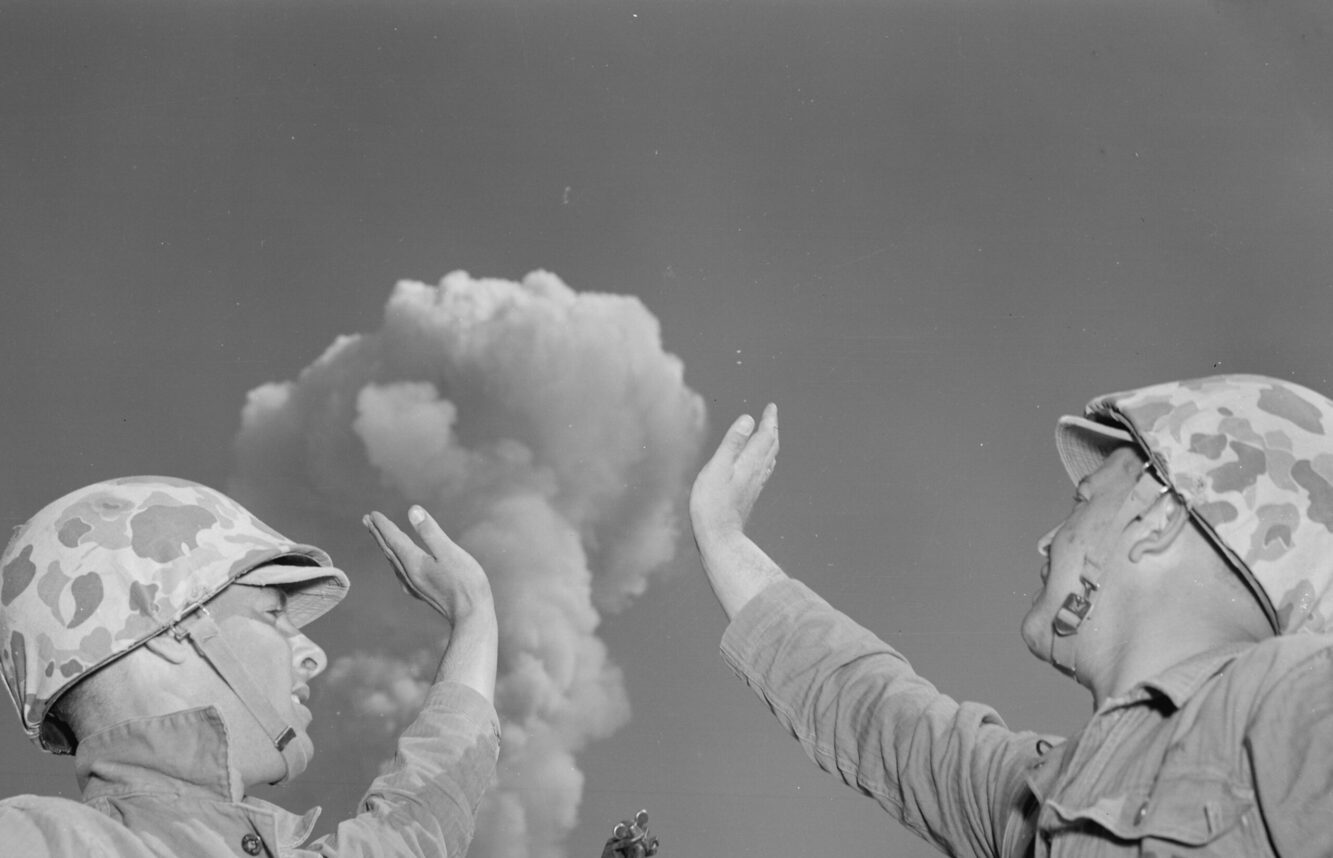There has been several comments regarding and questioning US and NATO ground elements capability to operate in a nuclear, chemical, biological and radiological environment. I figured I'd post items on the topic in a seperate thread to keep things from getting too jumbled....HC
----------------------------------------------------------------------
From 2019....
Posted for fair use......

Download the PDF

A 15-kiloton nuclear artillery round is fired from a 280-mm cannon 25 May 1953 at the Nevada Proving Grounds. Hundreds of high-ranking Armed Forces officers and members of Congress were present to observe the test. In future large-scale combat operations against enemies who possess nuclear weapons, doctrine needs to stipulate detailed planning required to preclude enemies from employing such weapons effectively against friendly forces. (Photo courtesy of the National Nuclear Security Administration/Nevada Field Office)
In October 2017, the U.S. Army released the new Field Manual (FM) 3-0, Operations, and other related doctrine for future conflicts.1 Military doctrine is an important component of any national grand strategy means-ends chain, conceptually designed to achieve national objectives.2 Doctrine focuses on the military means a state expects to employ and how it expects to employ them, and often centers on the preferred mode of fighting wars.3 Because military doctrine drives concepts about what military means are required and how to employ them, the doctrine must be integrated with the political grand strategy. Without coherent and integrated doctrine, the Army and other services are unlikely to be an effective means of achieving national military objectives.4 Ineffective military means either inhibit the options of political authorities, result in catastrophic failure, or increase costs and risks.5
FM 3-0 serves as the principle doctrine addressing tactics and procedures for conducting large-scale ground combat operations against peer and near-peer enemies, and supports many Army leaders’ inherent preference toward conventional war and decisive battle.6 However, FM 3-0 fails to adequately address the problem that three of America’s four potential peer or near-peer adversaries—Russia, China, and North Korea—possess nuclear weapons.7 In the past, nuclear weapons have typically limited war, as the alternative was to escalate to a nuclear exchange.8 Considering most American peer adversaries possess nuclear weapons, decisive victory will likely prove elusive in the future, and limited war and stability operations appear far more likely.
The U.S. Army and its allies should resist the urge to focus on large-scale military operations or, at a minimum, frame their approach to large-scale operations in a manner commensurate to the operational environment. The Army should also amend emerging doctrine to address the current gap related to nuclear weapons and include a discussion of operational approaches necessary for success against nuclear-armed adversaries. The Army is becoming too focused, doctrinally and conceptually, on large-scale war and requires more emphasis on smaller, limited conflicts. The figure depicts the U.S. Army’s focus on conventional military operations in the conflict spectrum and its limited attention on other more likely and more dangerous potential future conflicts. As the figure displays, it is arguable that the current FM 3-0 is only useful for a conflict against Iran since it is a potential large-scale threat without nuclear weapons.
Ivan Bloch foresaw many of the realities of World War I in La Guerre Future.9 He predicted that, because of technological advancements, war would become extraordinarily lethal and prevent armies from achieving decisive victory. He essentially argued that because of the current conditions, war—and by extension the military—was temporarily obsolete for resolving political disputes.10 Ignoring the more likely and dangerous potential future conflicts increases the risk that the Army will commit operational or strategic errors resulting in nuclear escalation, or, once again, make the service obsolete for resolving political disputes.
Wars between nuclear-armed powers have been, and will likely remain, extremely limited because of the risks nuclear escalation poses to both sides. Many scholars have discussed the limiting impact of nuclear weapons, and how any defeat that threatens core interests dramatically increases the risks of inadvertent escalation.12 Each historical direct conflict between nuclear powers, such as the 1969 Sino-Soviet border conflict and 1999 Indo-Pakistan conflict, has remained limited in scope, time, forces employed, methods used, and desired objectives.13 Even though these conflicts remained extremely limited, serious escalation risks and concerns arose. Any attempts to achieve decisive victory concerning vital interests for either opponent would almost certainly result in nuclear escalation.14
If the United States seeks a decisive victory, often by altering an adversary’s government, there would be little reason for an adversary to avoid using nuclear weapons.15 China, Russia, and North Korea are all highly centralized states that view internal stability and control as a vital interest of the government. All three states also have historical narratives that see themselves as victims of aggression by foreign powers and are extremely sensitive to potential oppression. Even if the United States avoided regime change, these potential adversaries would probably view any type of decisive military defeat as an existential threat to their internal stability and control. Further, miscalculation and misunderstandings in a large-scale conflict are likely and could easily lead to accidental escalation.16 Thus, in a conventional war, escalation would be likely due to either miscalculation or a U.S. adversary removing restraints on nuclear use because of an existential crisis.17
A future conflict against a nuclear-armed adversary should be characterized by managing escalation and focusing on limited objectives and means; if not, the United States should expect, and prepare for, nuclear war. Escalation management implies fighting—at all levels of war—in a manner designed to prevent inadvertent escalation to the nuclear exchange threshold. This threshold is difficult to determine but would most likely be crossed by causing an existential threat for one side. Because Army doctrine emphasizes the use of overwhelming force to achieve decisive results, the United States could easily cause an adversary to cross the nuclear threshold. Rather, future war may require returning to President Woodrow Wilson’s conception of “peace without victory,” because the threat of nuclear escalation makes it politically and strategically impractical to achieve a total victory.18
Continued.....
----------------------------------------------------------------------
From 2019....
Posted for fair use......

Emerging U.S. Army Doctrine
The author believes that limited warfare is much more likely in the future than large-scale combat operations (LSCO), as the threat posed by nuclear-armed adversaries decreases the likelihood of LSCO, and U.S. doctrine fails to consider the potential for the use of nuclear weapons.
www.armyupress.army.mil
Emerging U.S. Army Doctrine
Dislocated with Nuclear-Armed Adversaries and Limited War
Maj. Zachary L. Morris, U.S. Army
January-February 2019Download the PDF

A 15-kiloton nuclear artillery round is fired from a 280-mm cannon 25 May 1953 at the Nevada Proving Grounds. Hundreds of high-ranking Armed Forces officers and members of Congress were present to observe the test. In future large-scale combat operations against enemies who possess nuclear weapons, doctrine needs to stipulate detailed planning required to preclude enemies from employing such weapons effectively against friendly forces. (Photo courtesy of the National Nuclear Security Administration/Nevada Field Office)
In October 2017, the U.S. Army released the new Field Manual (FM) 3-0, Operations, and other related doctrine for future conflicts.1 Military doctrine is an important component of any national grand strategy means-ends chain, conceptually designed to achieve national objectives.2 Doctrine focuses on the military means a state expects to employ and how it expects to employ them, and often centers on the preferred mode of fighting wars.3 Because military doctrine drives concepts about what military means are required and how to employ them, the doctrine must be integrated with the political grand strategy. Without coherent and integrated doctrine, the Army and other services are unlikely to be an effective means of achieving national military objectives.4 Ineffective military means either inhibit the options of political authorities, result in catastrophic failure, or increase costs and risks.5
FM 3-0 serves as the principle doctrine addressing tactics and procedures for conducting large-scale ground combat operations against peer and near-peer enemies, and supports many Army leaders’ inherent preference toward conventional war and decisive battle.6 However, FM 3-0 fails to adequately address the problem that three of America’s four potential peer or near-peer adversaries—Russia, China, and North Korea—possess nuclear weapons.7 In the past, nuclear weapons have typically limited war, as the alternative was to escalate to a nuclear exchange.8 Considering most American peer adversaries possess nuclear weapons, decisive victory will likely prove elusive in the future, and limited war and stability operations appear far more likely.
The U.S. Army and its allies should resist the urge to focus on large-scale military operations or, at a minimum, frame their approach to large-scale operations in a manner commensurate to the operational environment. The Army should also amend emerging doctrine to address the current gap related to nuclear weapons and include a discussion of operational approaches necessary for success against nuclear-armed adversaries. The Army is becoming too focused, doctrinally and conceptually, on large-scale war and requires more emphasis on smaller, limited conflicts. The figure depicts the U.S. Army’s focus on conventional military operations in the conflict spectrum and its limited attention on other more likely and more dangerous potential future conflicts. As the figure displays, it is arguable that the current FM 3-0 is only useful for a conflict against Iran since it is a potential large-scale threat without nuclear weapons.
Ivan Bloch foresaw many of the realities of World War I in La Guerre Future.9 He predicted that, because of technological advancements, war would become extraordinarily lethal and prevent armies from achieving decisive victory. He essentially argued that because of the current conditions, war—and by extension the military—was temporarily obsolete for resolving political disputes.10 Ignoring the more likely and dangerous potential future conflicts increases the risk that the Army will commit operational or strategic errors resulting in nuclear escalation, or, once again, make the service obsolete for resolving political disputes.
The Future Near-Peer Environment and Limited War
FM 3-0 is primarily focused on large-scale ground combat operations, conceptually centered on fighting Army Chief of Staff Gen. Mark Milley’s 4+1 threats: Russia, China, North Korea, Iran, and violent extremist organizations. While FM 3-0 does many things exceptionally well—including developing the concepts of consolidating gains, shaping operational environments, and preventing conflicts—the three core chapters are dedicated to defeating peer and near-peer enemies during large-scale ground combat operations.11 However, these chapters fail to take into account the reality that these combat operations will happen against nuclear-armed opponents and thus either remain extremely limited (i.e., not large-scale) or probably result in a nuclear exchange.Wars between nuclear-armed powers have been, and will likely remain, extremely limited because of the risks nuclear escalation poses to both sides. Many scholars have discussed the limiting impact of nuclear weapons, and how any defeat that threatens core interests dramatically increases the risks of inadvertent escalation.12 Each historical direct conflict between nuclear powers, such as the 1969 Sino-Soviet border conflict and 1999 Indo-Pakistan conflict, has remained limited in scope, time, forces employed, methods used, and desired objectives.13 Even though these conflicts remained extremely limited, serious escalation risks and concerns arose. Any attempts to achieve decisive victory concerning vital interests for either opponent would almost certainly result in nuclear escalation.14
If the United States seeks a decisive victory, often by altering an adversary’s government, there would be little reason for an adversary to avoid using nuclear weapons.15 China, Russia, and North Korea are all highly centralized states that view internal stability and control as a vital interest of the government. All three states also have historical narratives that see themselves as victims of aggression by foreign powers and are extremely sensitive to potential oppression. Even if the United States avoided regime change, these potential adversaries would probably view any type of decisive military defeat as an existential threat to their internal stability and control. Further, miscalculation and misunderstandings in a large-scale conflict are likely and could easily lead to accidental escalation.16 Thus, in a conventional war, escalation would be likely due to either miscalculation or a U.S. adversary removing restraints on nuclear use because of an existential crisis.17
A future conflict against a nuclear-armed adversary should be characterized by managing escalation and focusing on limited objectives and means; if not, the United States should expect, and prepare for, nuclear war. Escalation management implies fighting—at all levels of war—in a manner designed to prevent inadvertent escalation to the nuclear exchange threshold. This threshold is difficult to determine but would most likely be crossed by causing an existential threat for one side. Because Army doctrine emphasizes the use of overwhelming force to achieve decisive results, the United States could easily cause an adversary to cross the nuclear threshold. Rather, future war may require returning to President Woodrow Wilson’s conception of “peace without victory,” because the threat of nuclear escalation makes it politically and strategically impractical to achieve a total victory.18
Continued.....
Last edited:





